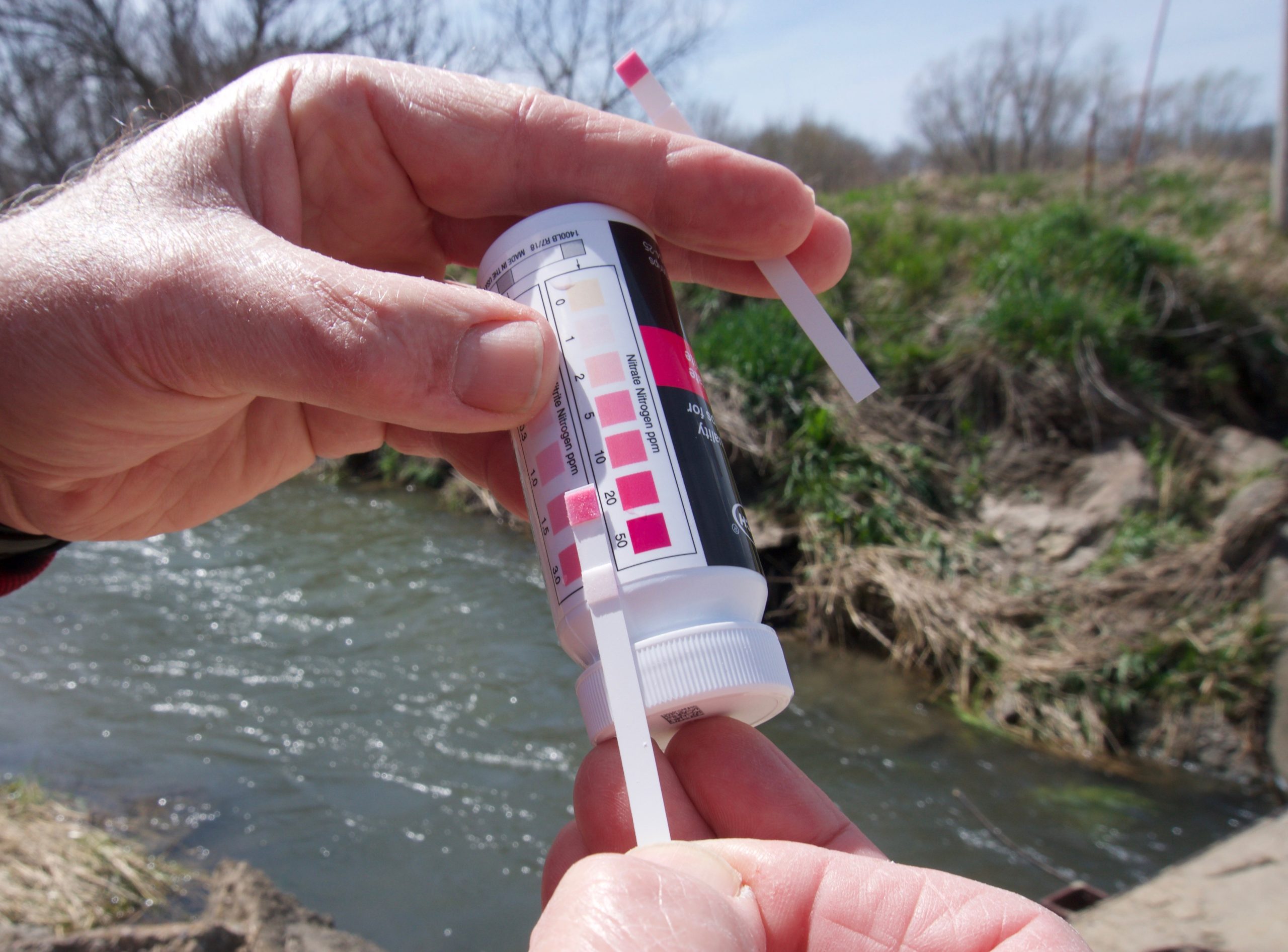This article was originally published by The New Lede.
EMMETSBURG, Iowa — Raised in rural Iowa, 71-year-old Maureen Reeves Horsley once considered her tiny hometown in the northwest part of the state to be a blessed space. She recalls a time when the streams here ran clean and the lake water was clear.
The family farm where Horsley grew up was one of more than 1,200 farms in Palo Alto County in 1970. In her memory, the county’s 13,000 residents enjoyed a thriving agricultural-based economy and close-knit neighbors. Cows grazed in verdant pastures. And seemingly endless acres of corn marched to the horizon.
“We had good crops, corn and soybeans,” Horsley said of her family’s farm along the West Fork of the Des Moines River. “You could make it on a small amount of farmland. You felt safe. It was a good life.”
Two generations later Emmetsburg and Palo Alto County have been radically transformed into a place where many residents worry that the farms that have sustained their livelihoods are also the source of the health problems that have plagued so many families.
Horsley, a certified nurse practitioner who now lives in nearby Ruthven, is among many Iowa residents who ask whether the farms that make up the lifeblood of Iowa’s economy have become a source of disease and death due to the toxic chemicals and other pollutants indelibly linked to modern agricultural practices.
“We drank the water on our farm,” Horsley said in an interview. “My sister had breast cancer. She was only 27 when she died. She grew up here. My other sister had uterine cancer. As a nurse practitioner I’m aware of five people now with pancreatic cancer. I know 20 people who have other cancers or died of cancer here. Look at the obituaries in our newspaper. Everybody is aware this is going on.”
Cancer cases climbing
Palo Alto’s 2022 tally of 842 farms generates nearly $800 million in annual market value. But nearly 400 small farms have been absorbed into bigger operations or otherwise stopped operating over recent decades, and Palo Alto’s population has dropped by 4,200 people since 1970.
Today’s Iowa farms are largely focused on raising hogs and growing corn, both of which are linked to numerous environmental problems. Farmers growing corn, for example, often rely heavily on applications of toxic pesticides and fertilizers, while livestock operations generate millions of tons of manure annually.
The chemicals and manure pollute food and water consumed by people even far from farm fields.
When nitrogen from fertilizer and manure combines with oxygen, it creates nitrates, which routinely drain from farm fields into groundwater, streams and rivers, contaminating water sources. Babies can suffer severe health problems when consuming nitrates in drinking water, and a growing body of literature indicates potential associations that include an increased risk of cancer. Exposure to elevated levels of nitrates in drinking water has been linked by researchers to cancers of the blood, brain, breast, bladder, and ovaries.
As well, there are years of research showing that many herbicides and other pesticides applied to farm fields are linked to cancers and other diseases.
Concerns about connections between the farm pollutants and cancer have been mounting, particularly in Palo Alto County, which had the highest incidence of cancer of any county in the state and the second-highest incidence of cancer among all U.S. counties, with 83 new cases of cancer on average each year in a population of 8,996, according to a 2023 report by US News.
The five-year incidence rate for cancer in Palo Alto County is 658.1, far higher than the national five-year average of 442 new cancer cases reported for every 100,000 people, according to the National Cancer Institute.

The concerns are not limited to Palo Alto County: Iowa has the second-highest and fastest-rising cancer incidence among all U.S. states, according to a 2024 report issued by the Iowa Cancer Registry.
Medical experts and state health authorities say it is difficult to pinpoint exactly what may be causing the prevalence of cancer in Palo Alto and Iowa overall. But many residents believe there is little doubt that the answers lie in the tide of farm pollutants pervading the environment.
“We are so heavily into agriculture in Iowa,” Horsley said. “Big chemical use. Big nutrient applications. What effect is that having on people? There needs to be more research on that.”

Cancer incidence in Iowa stayed mostly steady from 2001 to 2010, then dropped briefly before starting an upward climb after 2013, according to federal data. That’s 25 years – the scientifically-confirmed cancer latency period – after industrialized crop and livestock production really took hold in Iowa farming.
The Iowa Cancer Consortium, a 650-member collaboration of health professionals and government officials, launched a program in 2023 to understand environmental factors linked to cancer, among them radiation from radon and toxic compounds from agricultural wastes.
‘So much pain’
Some 300 miles southeast of Emmetsburg, David Dunn and his wife, Sharon Kendall-Dunn recalled how 10 years ago they were given the news that a mass in David’s abdomen was non-Hodgkin lymphoma (NHL), a cancer common in farm country nationally.
The couple did not work or live on a farm, yet their doctor indicated the environment could be to blame. Sharon remembers that when she asked the doctor how her husband could have gotten the disease, he told the couple simply — “You live in Iowa.”

Two years ago Sharon was also diagnosed with cancer, a type called chronic myeloid leukemia, which begins in the bone marrow. So far, treatment has helped keep her disease under control.
“I was in so much pain,” she said. “It’s better now.”
David’s cancer is under treatment, too.
“This is some kind of crazy,” David said. “I stopped dreaming. I stopped dreaming about retirement. I stopped dreaming about the kids graduating from college. I didn’t think I’d see them get married. I didn’t think I was going to hold a grandkid.”
Both Sharon and David grew up in Iowa. Other friends and family members have also been diagnosed with cancers, and some have died.
In the tiny farming town of Long Grove, Iowa, Chris Green mourns the 2019 death of her husband, who was stricken by the deadly brain cancer known as glioblastoma. With aggressive treatment, Jim Green lived nearly two years following his diagnosis but ultimately succumbed.
“He said to me, ‘You know, I can’t do this anymore.’” Chris recalled. “So we had hospice come in. Jim passed in the living room … surrounded by family.”
Before he died, at age 65, Jim worked nearly 39 years on the maintenance staff of an aluminum plate rolling mill in Davenport. His exposure to various industrial chemicals at the mill could have been a factor in his disease, but some studies also link pesticides, such as those used commonly on farms, to glioblastoma.
Chris said she knows of at least nine other people in her community who have died from glioblastoma in the last several years.
“What you’re seeing in Iowa is a problem,” said Molly Jacobs, an epidemiologist at the University of Massachusetts. “You can see it from the experience on the ground. The message from me is to put energy into reducing exposure to the known harms.”
More research needed
The pesticides used on Iowa farmland are seen as a likely culprit for at least some of the cases, experts said.
The National Cancer Institute and the National Institute of Environmental Health Sciences have been funding research to investigate the links between disease and farming for more than 30 years, focusing their work on people in Iowa and North Carolina. Among the findings are links between pesticides and malignant brain tumors, multiple myeloma, pancreatic cancer, and certain breast cancers.
“We have a very high percentage of our land that is growing crops,” said Dr. Richard Deming, an oncologist in the state’s capital city of Des Moines. “The current way of growing crops is to use a lot of ag chemicals, which have improved the yield of crops. Is there, potentially, a downside? That’s where we really need to do more research. There is certainly circumstantial evidence that we’re probably exposed to more ag chemicals just because of the nature of Iowa, and the number of acres of Iowa that are under agricultural production.”
Living in a place with cancer rates nearly 50% higher than the national average prompted Linus Solberg, a farmer and a Palo Alto County supervisor, to ask area health authorities for assistance in understanding the sources for disease and reducing risks. He said he knows state universities have studied the problem, but sees little being done to address the risks.
Solberg’s father developed prostate cancer, and his mother died at age 69 of ovarian cancer, while his wife and three neighbors on his road also died of cancer.
“So that’s six right there on two miles along this road,” he said. “I don’t know if it’s pesticide or electrical. We have all these windmills. I don’t know if it’s in the water. I have no idea.”
The county’s health authorities say they are expanding screening programs for breast, lung, prostate, and colon cancer, counseling residents on smoking and diet, and testing homes for radon, a naturally occurring radioactive gas and a proven carcinogen.

“Organizationally, we’ve concentrated on early detection, and health and wellness,” said Jonathan Moe, chief executive officer of the Palo Alto County Health System.
The county also tests residential drinking water wells for contaminants under a state-funded program.
Ben Huntley, the environmental health specialist who manages the well testing program, sampled 121 homes over the past 24 months. According to his records, three samples were above the 10 parts per million federal drinking water limits for nitrates.

The much larger hazards were E.coli bacteria – 30 samples above safety limits – and arsenic, a naturally occurring mineral and a carcinogen linked to lung, bladder and kidney cancer – that exceeded the safety standard in 45 wells.
Settled by Irish immigrants in the mid-19th century, Palo Alto County has endured bad crop years, the deep drought of the early 20th century, and the 1980s farm crisis. Now cancer is laying claim as an Iowa calamity.
“In the old days, the farmers lived longer lives if they didn’t die from an accident on the farm,” Horsley said. “Now everybody is getting checkups and finding out they have prostate cancer, or they’ve got glioblastoma, or they’ve got cancer in the lymph nodes. We need to find out what’s going on.”
The report is part of an ongoing series looking at how agricultural policies are affecting human and environmental health.













